7 Hawks in Indiana
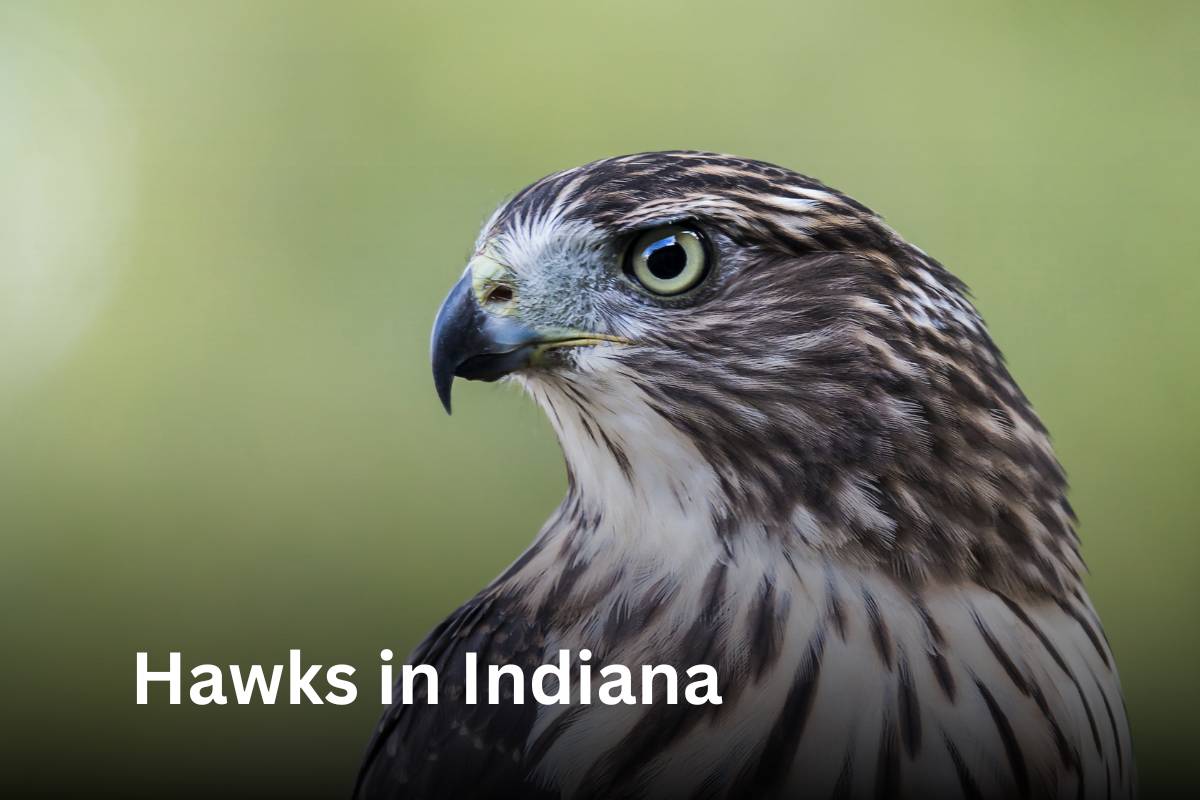
Despite its agricultural environment and bustling urban centers, Indiana is home to a broad range of animals, including many hawk species.
These spectacular birds of prey are essential to the state’s ecosystem, helping maintain the natural balance.
Indiana provides environments for numerous species of hawks to thrive, from the wooded areas in its southern sections to the broad farmlands in the north.
In this blog, we look at the exciting world of hawks in Indiana, including their habitats and behaviors.
Join us on a journey to uncover the breathtaking beauty and significance of hawks in Indiana State.
List of 7 Hawks in Indiana
- Sharp-shinned Hawk (Accipiter Striatus)
- Cooper’s Hawk (Accipiter Cooperii)
- Red-shouldered Hawk (Buteo Lineatus)
- Broad-winged Hawk (Buteo Platypterus)
- Red-tailed Hawks (Buteo Jamaicensis)
- Rough-legged Hawk (Buteo Lagopus)
- Northern Harrier (Circus Hudsonius)
1. Sharp-shinned Hawk
The sharp-shinned or northern sharp-shinned hawk, sometimes known as a sharpie, is a little hawk.
- Scientific name: Accipiter Striatus
- Size: 24-34 centimeters(9.4-14.4 inches)
- Wingspan: 43-56 centimeters (16.9-22.1 inches)
- Weight: 87-218 grams(3.1-7.7 oz)
- Lifespan: Three years
- Conservation status: Low Concern (Population is growing)
Sharp-skinned hawk adults have blue-gray upper parts, white underparts, and white necks. They are little hawks with long tails and short, rounded wings.
The average life span of a sharp-skinned hawk is three years, but hawks over ten years old are not unusual. The Sharp-Skinned Hawk population has been very steady.
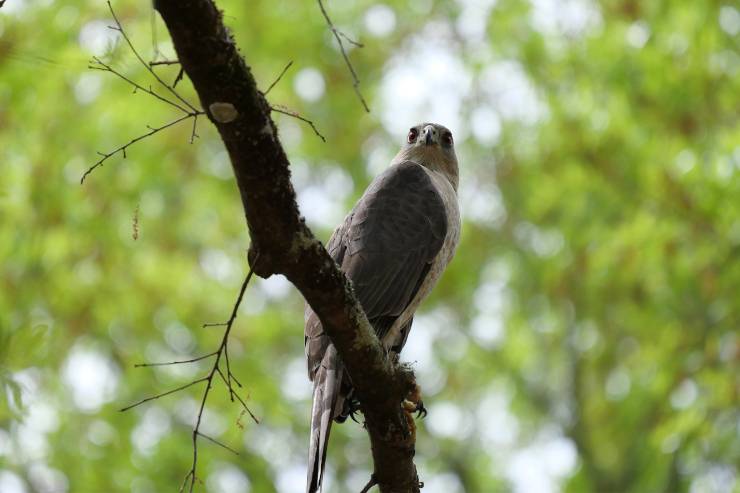
Habitat: Sharp-shinned hawks are infrequent breeders in Indiana, but they can be found primarily during spring and fall migrations and throughout winter.
They prefer the cover of dense forests, occasionally venturing out into the open to circle the sky or fly across a field in the summer. However, they do visit rural or suburban areas with some tree cover.
Feeding: The Sharp-shinned Hawk generally eats small birds ranging in size from sparrows to robins, but it will occasionally feed on larger species such as quails.
In addition, it feeds its diet with rodents, squirrels, bats, lizards, snakes, frogs, and more giant insects.
2. Cooper’s Hawk
Cooper’s hawks are medium-sized hawks.
- Scientific name: Accipiter Cooperii
- Size: 37-39 centimeters (14.6-15.3 inches)
- Wingspan: 62-90 centimeters (24.4-35.4)
- Weight: 220-410 grams (7.8-14.5 oz)
- Lifespan: 12 years
- Conservation status: Low concern(Population growing)
They have moderate-length wings, a long, typically curved or even wedge-shaped tail, and long but relatively stout legs and toes.
These creatures have an erect posture and a lengthy tail. Their upperparts are bluish-gray, with a striking black cap and crimson eye. Cooper’s Hawks live for twelve years.
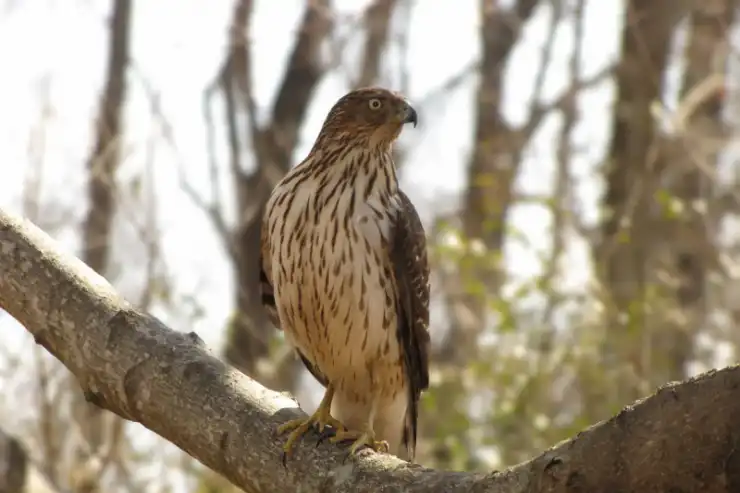
Although the population of Cooper’s Hawks decreased in the mid-twentieth century due to human persecution and the use of DDT.
| Note: DDT, or dichlorodiphenyltrichloroethane, is an agricultural insecticide. |
This species has rebounded remarkably well. Cooper’s Hawk populations are currently increasing.
Habitat: Cooper’s Hawks inhabit various wooded and semi-wooded habitats over southern Canada, the majority of the United States, and certain parts of Mexico. They prefer higher trees.
Feeding: The Cooper’s Hawk primarily eats birds and small mammals. It typically hunts medium-sized birds such as jays, flickers, and robins, although it also preys on larger and smaller avian species.
In addition to birds, it eats small mammals like chipmunks, tree and ground squirrels, and bats.
3. Red-shouldered Hawks
Red-shouldered hawks are medium-sized buteos.
- Scientific name: Buteo Lineatus
- Size: 43-61 centimeters (16.9-24.0 inches)
- Wingspan: 94-111 centimeters (37.0-43.7 inches)
- Weight: 486-774 grams (17.1-27.3 oz)
- Lifespan: 5 years (in wild)
- Conservation status: Least Concern
These adult hawks are brightly colored, with dark-and-white speckled wings and warm reddish stripes on the breast.
Their tail is black with tiny white bands. Immatures Red-shouldered hawks are brown on top and white on the bottom, with brown streaks. Red-shouldered hawks can live up to 5 years in the wild.
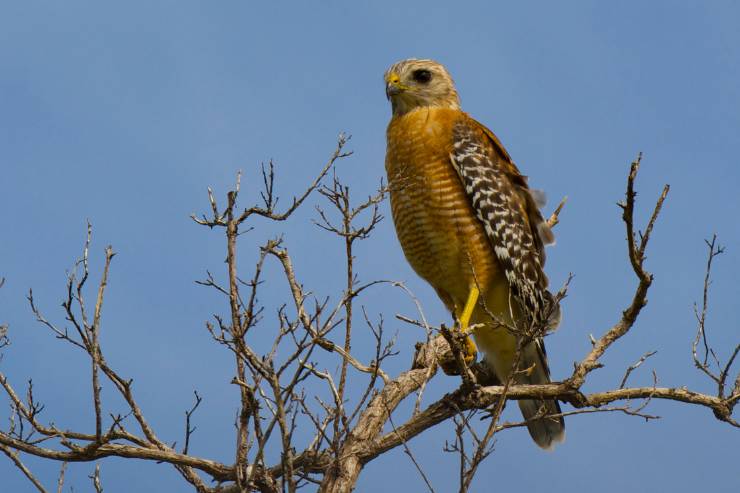
Although Red-shouldered Hawks are a low-risk species, deforestation is the most severe conservation danger to these widespread species.
Habitat: Red-shouldered Hawks like big, mature, contiguous, mixed deciduous coniferous woods. These species prefer wet woodlands, specifically bottomlands near rivers, marshes, swamps, and streams.
Feeding: The Red-shouldered Hawk’s main diet consists of small mammals, reptiles (such as lizards and snakes), and amphibians. They occasionally eat crawfish and other birds.
4. Broad-winged Hawk
The broad-winged hawk is a medium-sized hawk belonging to the Buteo genus.
- Scientific name: Buteo Platypterus
- Size: 33-44 centimeters (13.4-17.3 inches)
- Wingspan: 81-100 centimeters (31.9-39.4 inches)
- Weight: 265-560 grams (9.3-19.8 oz)
- Lifespan: 12 years
- Conservation status: Least Concern
Broad-winged Hawks have reddish-brown heads, barred underparts, and huge black and white stripes on their tails.
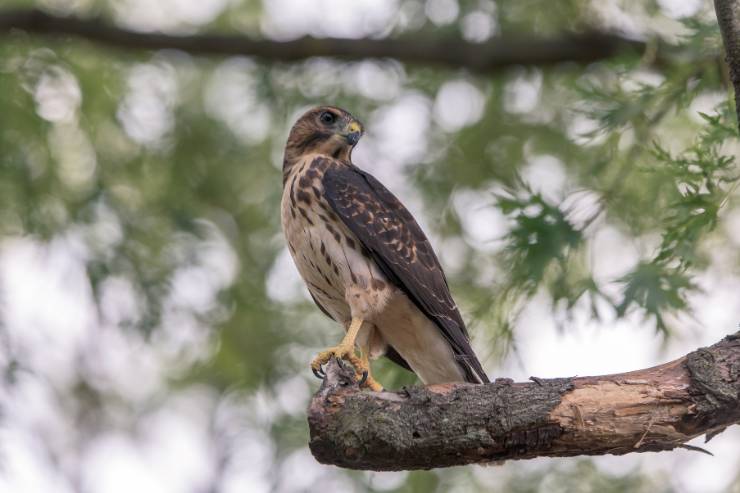
They have white undersides of the wings, which are edged with dark brown. According to research conducted between 1955 and 1979, the average lifespan of wild broad-winged hawks is 12 years.
The first known wild broad-winged hawk survived for at least 14 years and four months. The IUCN classifies broad-winged hawks as a species of most minor concern.
Although broad-winged hawk populations are reasonably constant, they are dropping in some areas due to forest fragmentation.
Habitat: The Broad-winged Hawk lives in dense, continuous, or mixed deciduous/coniferous woodlands.
Feeding: Broad-winged Hawks eat various foods, including small animals, amphibians, reptiles, and birds. Their diverse diet includes mice, voles, squirrels, and other small animals (toads, frogs, snakes, and lizards).
They also eat numerous tiny birds and huge invertebrates and occasionally eat crayfish, centipedes, fish, and earthworms.
5. Red-tailed Hawks
Most Red-tailed Hawks are rich brown above and light below, with a striped belly and a dark bar on the wing underside between shoulder and wrist.
Their tails are typically whitish below and cinnamon-red above.
- Scientific name: Buteo Jamaicensis
- Size:- 45-56 centimeters (17.7-22.1 inches)
- Wingspan: 114-133 centimeters (44.9-52.4 inches)
- Weight: 690-1300 grams (24.3-45.9 oz)
- Lifespan: 12 (years in the wild), 30 years (in captivity)
- Conservation status: Widespread and common
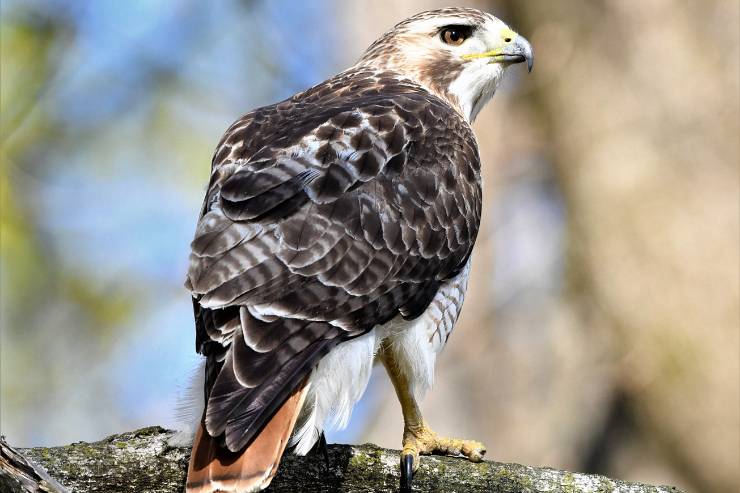
Red-tailed hawks have an average lifespan of 12 years in the wild but can live up to 30 years in captivity. It’s familiar and widespread.
It has increased in some locations since the 1960s, with current numbers constant or rising.
Habitat: The red-tailed hawk lives in various surroundings and altitudes, including deserts, grasslands, coniferous and deciduous woods, agricultural fields, and urban areas.
Its latitudinal limits are at the tree line in the subarctic, and it is not present in the high Arctic. Generally, it prefers a variety of environments, including open woodland, woodland edge, and open terrain.
| Note: It is legally protected in the United States, Mexico and Canada under the Migratory Bird Treaty Act. |
Feeding: Red-tailed hawks are versatile in their diet, adjusting to seasonal offerings. Their primary prey includes squirrels, but they also consume rodents, reptiles, rabbits, and various birds.
Additionally, they are known to grab food from other raptors, such as eagles and owls.
6. Rough-legged Hawk
The rough-legged hawk was also known as the rough-legged falcon.
- Scientific name: Buteo Lagopus
- Size: 47-52 centimeters (18.5-20.5 inches)
- Wingspan: 132-138 centimeters (52.0-54.3 inches)
- Weight: 715-1400 grams (25.2-49.4 oz)
- Lifespan: Two years
- Conservation status: Least Concern
Rough-legged Hawks are giant hawks with broad wings that are relatively long and narrow compared to other Buteo hawks.
The tail is likewise longer than in most other Buteos. Rough-legged hawks have an average life span of two years. The overall population of rough-legged Hawks is well and of least concern.
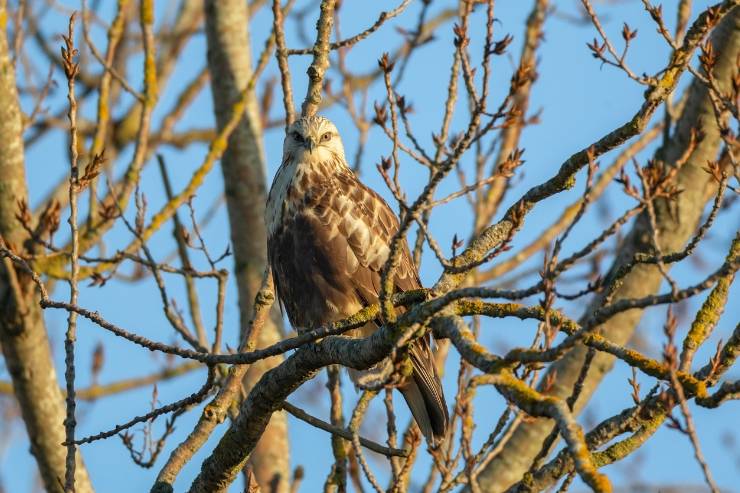
Habitat: During the breeding season, Rough-legged hawks can be found in Arctic and Subarctic areas across North America, Europe, and Russia, but they migrate south in the winter.
During wintertime, they live in open areas such as fields, grasslands, marshes, and farmland.
Feeding: Rough-legged Hawks mainly feed on tiny rodents such as lemmings and voles during breeding.
In the winter, Rough-legged Hawk’s diet consists primarily of small mammals, including mice and shrews; they also sometimes pursue larger species like Arctic Ground Squirrels and rabbits.
7. Northern Harrier
Northern Harriers are commonly known as ring-tailed hawks or marsh hawks
- Scientific name: Circus Hudsonius
- Size: 46-50 centimeters (18.1-19.7 inches)
- Wingspan: 102-118 centimeters (40.2-46.5 inches)
- Weight: 300-750 grams (10.6-26.5 oz)
- Lifespan: 16 years and 6 months
- Conservation status: Least concern (but population decreasing)
They are easily recognised from a distance. They have a thin, long-tailed hawk hovering low over a marsh or grassland, keeping its wings in a V-shape and showing a white patch at the base of their tail.
The maximum recorded lifespan is 16 years and five months, with an average lifespan of approximately 16.6 months.
| Note: The population is generally stable but it is experiencing a slight decline across its habitat range. |
Habitat: During the winter, the northern harrier migrates southward, breeding birds from Canada and the northern Great Plains of the United States and visiting locations in the American South, Mexico, and Central America.
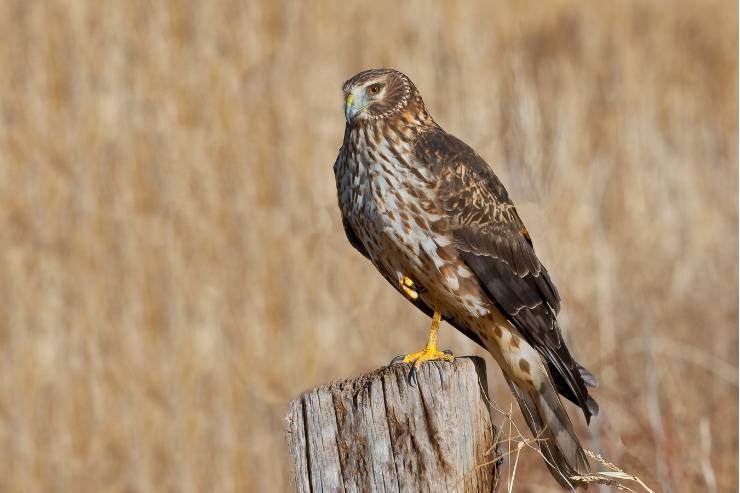
They may be found throughout the year in several places of the United States, including the midwestern, mountain west, and North Atlantic states.
The northern harrier prefers open areas like marshes and grasslands throughout its range. Typically, these birds build their nests on the ground alone or in loose clusters.
However, in the Northeast, sufficient habitat availability is a concern due to the loss of open spaces caused by wetland damage and agricultural land regrowth.
Feeding: During the summer, harriers generally hunt small to medium-sized mammals, particularly rodents, birds, reptiles, amphibians, and insects.
In the winter, animals and birds are the primary sources of their food, though each harrier’s precise diet varies based on its location.
Conclusion
At last, Indiana’s diverse scenery, ranging from rural to urban regions, provides habitat for many hawk species.
These birds are vital for maintaining the state’s environmental balance, from the sharp-shinned hawk to the majestic red-tailed hawk. Despite significant problems, such as habitat loss and environmental change, many hawk populations in Indiana are resilient and stable.
The existence of these raptors enhances the state’s natural heritage by allowing enthusiasts and bird lovers to witness and appreciate their beauty and value.
Through conservation efforts and ongoing awareness, Indiana can continue to be a haven for these extraordinary birds of prey, ensuring their survival and contributing to the health of its ecosystems for future generations.
Frequently Asked Question
What hawk species can be found in Indiana?
Indiana is home to various hawk species, including the Red-tailed Hawk, Cooper’s Hawk, Sharp-shinned Hawk, Northern Harrier, and Broad-winged Hawk.
Where are the best places to spot hawks in Indiana?
Hawks live in a variety of habitats in Indiana, including grasslands, fields, woodlands, and wetlands. Hawks live on urban and suburban roadsides, parks, and cemeteries.






